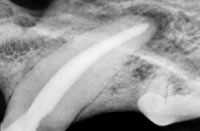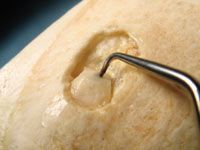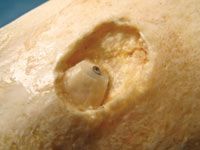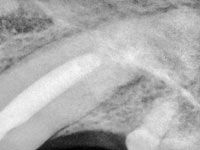An unusual gingival lesion: the resolution
Root-canal therapy was chosen to avoid surgery on the patient mentioned in the first two parts of this series. While root canal is very successful, not all cases respond. Additional therapy may be required.
The last article in this case presentation outlines the potential options for resolution of an unusual gingival lesion (first presented in the June and August issues and available at dvm360.com/beckman).

Photo 1: The completed root-canal procedure shows a radiographically adequate canal fill.
Root-canal therapy and extraction options were given to the client, and root-canal therapy was desired to retain the tooth and avoid surgery. Although root-canal therapy is very successful, not all cases respond; additional therapy may be required. Pet guardians must be made aware of this.
Root-canal therapy was performed on this patient using rotary instrumentation. The result was radiographically sound with no voids and a good fill of the apical (root-end) portion of the canal (Photo 1).

Photo 2: Cast-metal alloy crowns protect the access site and eliminate crown wear if continued trauma is anticipated.
Gutta percha is represented by the radiodense material within the root-canal system. Please see the June 2009 article for a basic overview of root-canal therapy. No air or instrument voids are present within the gutta percha. Prognosis is good for resolution of the fistula and eventual resolution of the defect. Radiographic follow-up should be recommended at six months and at 12-month intervals until resolution of the bone lucency is documented.
Cast-metal alloy crowns generally are recommended for most root-canal procedures to protect the access site composite from breaking down and allowing microleakage of oral fluids into the pulp cavity (Photo 2).
A major reason for root-canal failure is the inability to achieve a good, sterile seal at the apex through proper cleaning, shaping and obturation. Microleakage at the access site on the crown is another major reason for failure of root-canal procedures in humans and veterinary patients.

Photo 3: Special retrograde endodontic tips are available for removing obturation material (gutta percha) during surgical root-canal procedures. This demonstrates the surgical endodontic tip cleaning the root end in preparation for the filling material.
Cast-metal alloy crowns help minimize the potential for access-site failure. Crown placement in this particular case was discussed. The recommendation for this patient was to wait until short-term resolution of the fistula could be documented and radiographic evidence of bone fill within the existing radiographic lucency could be appreciated.
Despite recommendations for radiography at a six-month follow-up, the patient returned 11 months later for another problem. The fistula had not resolved. Radiography revealed lack of bone fill in the periapical region.

Photo 4: This demonstrates the final root end fill with mineral trioxide aggregate.
Exploring the options
Now what are our options? Extraction is one very viable one. Redoing the root-canal procedure is certainly an option. Although the radiographic appearance suggests that the obturation is adequate, this does not ensure the perfect outcome.
A surgical root canal is a third option. A surgical (retrograde) approach will allow for immediate visual removal of all diseased periapical tissue including a portion of the root tip. This approach carries a higher possibility for success in this case.
Surgical root-canal therapy is accomplished by approaching the root-canal system through an incision over the bone at the root tip. The radiographically visible void in the bone generally represents granulation tissue, as was the case here. Cysts and abscesses are possible but are much less common. The diseased tissue in this case was extensive.

Photo 5: The surgical access location at the root tip shows synthetic bioglass placed following the surgical root canal to form a scaffold for new bone growth.
Granulation tissue was debrided and rough bone was smoothed with a curette prior to proceeding with the procedure. Generally 5 mm of root is excised with the aid of a bur on a high-speed handpiece following removal of the bone on the vestibular (lateral) aspect of the root tip. Special tips placed upon a piezoelectric scaler (Photo 3) aid in removing several millimeters of gutta percha to make room for the root-end filling material.

Photo 6: The radiographic appearance of the MTA placement and synthetic bioglass within the bone defect. A slight change in radiodensity at the root end represents the MTA vs. gutta percha.
Although a variety of compounds historically have been used to seal the root tip, mineral trioxide aggregate (MTA) is a compound that is now widely accepted as a root-end filling material. Special instruments facilitate mixing and placement. In several hours this biologically friendly cement hardens to seal the root canal (Photo 4).
In this case, a synthetic bone-graft particulate was used to fill the massive void in the bone that was left following removal of the granulation tissue and root-tip removal (Photos 5 and 6).
Resolution of the lesion was rapid. The clients, although not aware of any activity changes prior to surgery, mentioned positive activity and attitude changes three days postoperatively. Radiographic follow-up has not been an option in this case due to owner reluctance in light of continued clinical resolution and other more pressing medical issues.
Root-canal therapy in this case failed to resolve the fistula. It is likely that the degree of bone destruction prior to therapy was so extensive that root-canal therapy would fail regardless. It could be that the perfect fill was not attained, resulting in failure.
Unfortunately, most of our patients with endodontic disease don't show gross changes like this patient. Radiographic evidence usually is the only way to definitively recognize pulp death with associated root-canal diameter and periapical changes. Keep this in mind when evaluating the dentition of all of your patients. Proper diagnostics will minimize the potential for severe disease and fistula formation as seen in this patient.
by Brett Beckman DVM, Dipl. ACVD, Dipl. AAPM Dr. Beckman is acting president of the American Veterinary Dental Society and owns and operates a companion-animal and referral dentistry and oral surgery practice in Punta Gorda, Fla. He sees referrals at Affiliated Veterinary Specialists in Orlando and at Georgia Veterinary Specialists in Atlanta, lectures internationally and operates the Veterinary Dental Education Center in Punta Gorda.
For a complete list of articles by Dr. Beckman, go to dvm360.com/beckman